Contributory members are able to log private notes and comments about each site
Sites Anne T has logged. View this log as a table or view the most recent logs from everyone
Millstone Burn 1c
Trip No.71 Entry No.8 Date Added: 9th May 2018
Site Type: Rock Art
Country: England (Northumberland)
Visited: Yes on 7th May 2018. My rating: Condition 2 Ambience 3 Access 4
Millstone Burn 1c submitted by SolarMegalith on 7th Jun 2013. General view of the cup-marked boulder as seen from the east (photo taken on June 2013).
(View photo, vote or add a comment)
Log Text: Millstone Burn 1c: This panel was very near the road (some motorists tooted their horns as they went past) and parts of it were under turf and moss. Part of the line of cups visible on the ERA photographs were covered by moss, which we left undisturbed. It was difficult to distinguish any other cups on the rock, despite having the ERA images on my phone to compare it to.
Millstone Burn 1e
Trip No.71 Entry No.6 Date Added: 9th May 2018
Site Type: Rock Art
Country: England (Northumberland)
Visited: Yes on 7th May 2018. My rating: Condition 2 Ambience 3 Access 4

Millstone Burn 1e submitted by Anne T on 9th May 2018. Millstone Burn 1e was too heavily under moss to make out any motifs at all. We didn't want to move any moss, so left the panel as it was.
(View photo, vote or add a comment)
Log Text: Millstone Burn 1e: On the eastern side of the A697, not far from the gate into the field. This was the stone at the grid reference given, but was almost completely buried under moss/turf, with one end of it seeming to have been grazed by farm machinery, which had taken off the moss and a shallow layer of stone. We left the moss as it was, not wanting to harm the motifs (but then NADRAP said they didn't observe anything).
Millstone Burn 2e
Trip No.71 Entry No.5 Date Added: 9th May 2018
Site Type: Rock Art
Country: England (Northumberland)
Visited: Yes on 7th May 2018. My rating: Condition 2 Ambience 3 Access 4
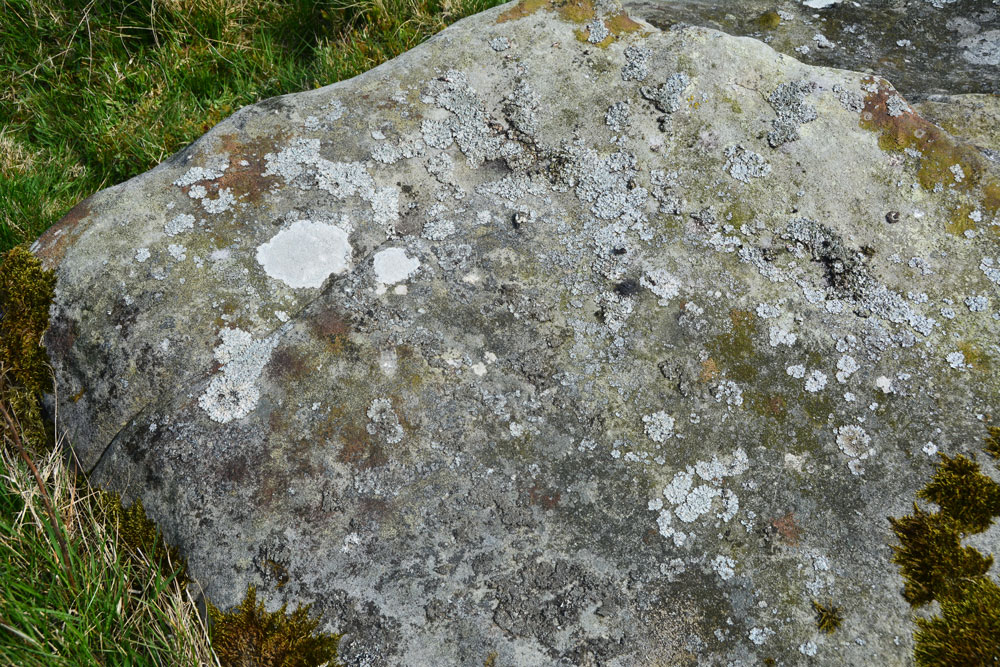
Millstone Burn 2e submitted by Anne T on 9th May 2018. In typical Tate fashion, we didn't remember to take any water along to try and highlight the motifs. We did struggle to find them!
(View photo, vote or add a comment)
Log Text: Millstone Burn 2e: This rock is not far upslope from Millstone Burn 2dd and 2d. Again, without GPS we would have struggled to find this rock, and we did struggle to identify any of the motifs - Beckensall described these as two ringed cups and two other cups, one with a natural groove leading to it and a pecked groove leading away from the ring. By the time of the NADRAP survey, they recorded a cup and very thin ring with groove running to the northern edge of the outcrop.
This stone was very interesting as downslope it had a step in it, and not only was there a channel wearing, but there were green water stains from where rain water had trickled down the slight slope of the rock downhill.
These motifs must have been placed to have been seen as you were coming down or up the slope.
Millstone Burn 2dd
Trip No.71 Entry No.4 Date Added: 8th May 2018
Site Type: Rock Art
Country: England (Northumberland)
Visited: Yes on 7th May 2018. My rating: Condition 2 Ambience 3 Access 4
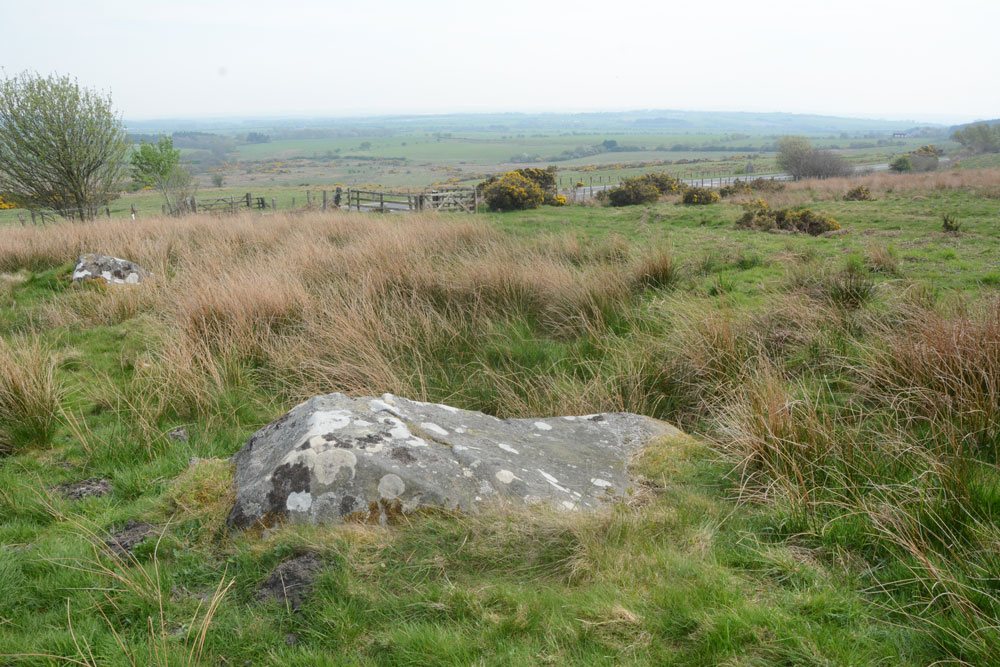
Millstone Burn 2dd submitted by Anne T on 8th May 2018. Millstone Burn 2dd panel, looking east across the A687.
(View photo, vote or add a comment)
Log Text: Millstone Burn 2dd: only 15m away from Millstone Burn 2d, and relatively easy to find amongst all the other boulders in the field. As these motifs are on top of the rock, they must have been designed to have been seen as you were coming down the hillside.
This rock looks very different shapes depending on what angle you view it at. We had huge difficulty making out any cup marks at all beneath the lichen and moss, although there are some grooves, which look as if they have been created (enhanced?) by rainwater trickling down and over the side of the rock over the years.
Not the best example of rock art we've seen, but one to tick off the list.
Millstone Burn 2d.
Trip No.71 Entry No.3 Date Added: 8th May 2018
Site Type: Rock Art
Country: England (Northumberland)
Visited: Yes on 7th May 2018. My rating: Condition 3 Ambience 3 Access 4
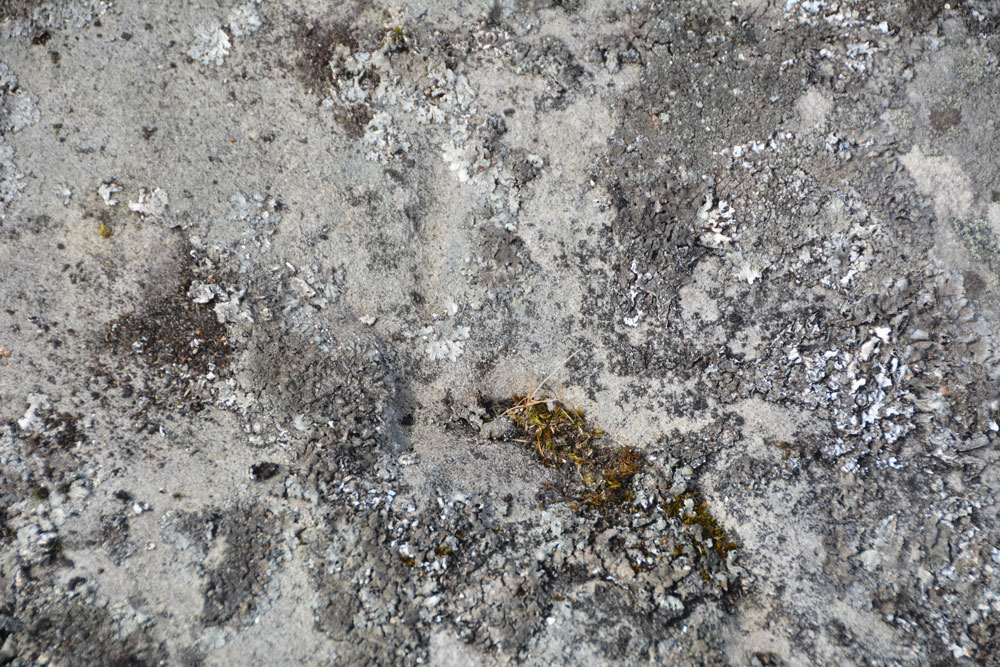
Millstone Burn 2d. submitted by Anne T on 8th May 2018. The area of mechanical damage towards the centre of the rock.
(View photo, vote or add a comment)
Log Text: Millstone Burn 2d: Closer to the A697, it's a good job we had the GPS to find this panel. In usual Tate style, we'd brought everything but a bottle of water to bring out the motifs. I had to call up the ERA media (photos and sketch) on my phone to ensure we understood what we were seeing. There really are cups beneath the lichen and moss, easier to feel with the fingers and see with the naked eye.
Millstone Burn 2bb
Trip No.71 Entry No.2 Date Added: 8th May 2018
Site Type: Rock Art
Country: England (Northumberland)
Visited: Yes on 7th May 2018. My rating: Condition 3 Ambience 3 Access 4
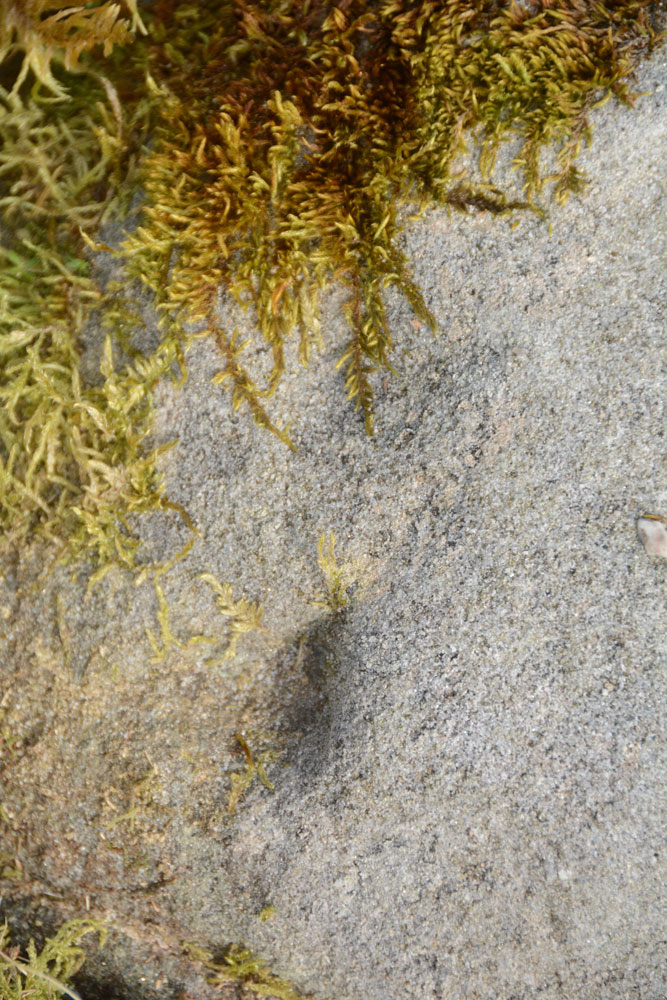
Millstone Burn 2bb submitted by Anne T on 8th May 2018. The oval and groove, as shown on the ERA drawing for Millstone Burn 2bb.
(View photo, vote or add a comment)
Log Text: Millstone Burn 2bb: This would be a 'short walk on a footpath' if we'd come in through the gate we used at our last visit. This time we approached it from Millstone Burn 2c, walking down the hill towards the start of the bend in the A697 from Longframlington. The rock was instantly recognisable from ERA's description, as was finding the two indentations at its apex and the oval and groove on ERA's drawing. The three cup marks in a line were there, but underneath a heavy covering of moss and lichen. They could be felt by running your fingertips over the rock.
Millstone Burn 4c
Trip No.71 Entry No.1 Date Added: 8th May 2018
Site Type: Rock Art
Country: England (Northumberland)
Visited: Yes on 7th May 2018. My rating: Condition 3 Ambience 4 Access 3

Millstone Burn 4c submitted by Anne T on 8th May 2018. Close up of the two cup marks, with some of the iron containing sandstone showing up red. These two cups appeared linked by a very faint groove, which could be felt with the finger tips.
(View photo, vote or add a comment)
Log Text: Millstone Burn 4c: It was so hot at home this morning that we decided to seek cooler climes. Husband had compiled a list of rock art panels that looked interesting and their grid references. After having found the gps, we set off for Longframlington, this time parking round the bend at a larger entrance to a slightly different field at NU 11525 05542. This meant walking through virtually knee high heather up to the top of the slope, but we found some paths had been mown through the heather. At the top of the hill, we had to clamber over a double barbed wire fence to get to the main outcrop (there wasn’t a gate for some way).
What we actually saw was Millstone Burn 4c at NU 11516 05169, part of the same outcrop as Millstone Burn 4a and 4b (thank heavens for GPS). Two cups were very obvious, together with some of the iron stone banding/staining. These two cups appeared to be joined by a very faint groove, which could be felt with the fingertips. Much of the rest of the panel was under turf, which we left undisturbed to protect the rock art underneath.
Millstone Burn 1d
Trip No.71 Entry No.6 Date Added: 7th May 2018
Site Type: Rock Art
Country: England (Northumberland)
Visited: Yes on 7th May 2018. My rating: Condition 2 Ambience 4 Access 4
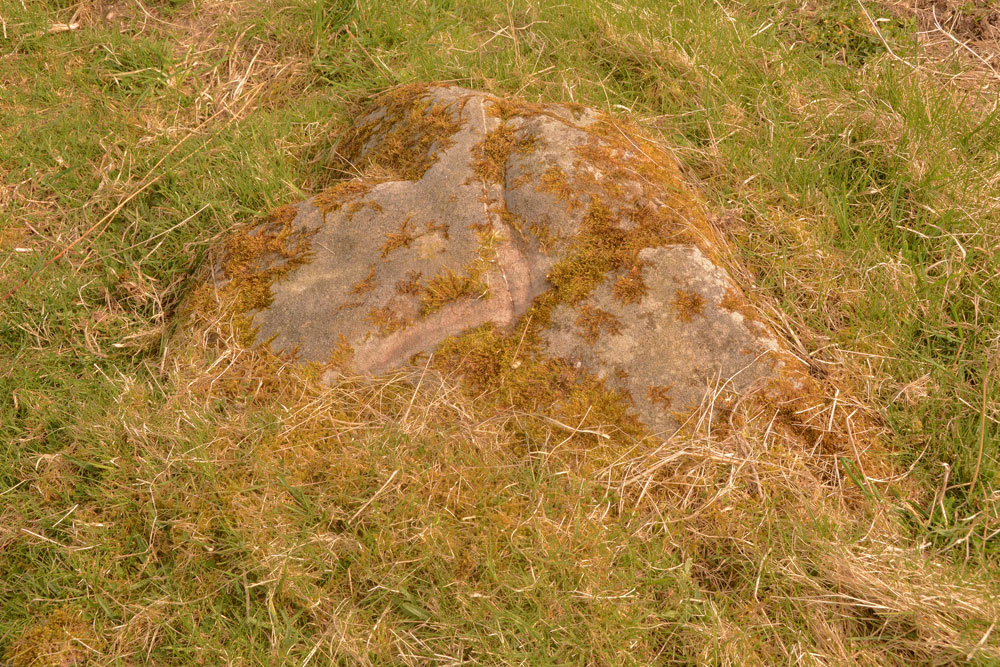
Millstone Burn 1d submitted by Anne T on 7th May 2018. Millstone Burn 1d from a different angle, showing the 'scar' across the middle of the rock, which looks relatively recent.
(View photo, vote or add a comment)
Log Text: Millstone Burn 1d: This rock art panel is just to the east of the A697 and largely covered in turf. There is a deep scar in the rock which looks relatively recent. It also has a curious vein of quartz which runs through the rock.
Long Stone (Barcombe Hill)
Trip No.70 Entry No.2 Date Added: 6th May 2018
Site Type: Ancient Cross
Country: England (Cumbria)
Visited: Yes on 5th May 2018. My rating: Condition 3 Ambience 4 Access 4

Long Stone (Barcombe Hill) submitted by Anne T on 6th May 2018. The Long Stone from the west, looking back towards Barcombe Iron Age defended settlement.
(View photo, vote or add a comment)
Log Text: The Long Stone, Barcombe Hill: we always thought this was a modern marker stone, sitting high above Stane Way. We also thought it was difficult to get to. Not so. There are well mown grass trackways that lead from Barcombe Iron Age Defended Settlement/Roman Signal Station, as well as from the Trig Point on Barcombe Hill. We approached from the trig point, which is higher than this stone and the settlement.
The whole stone and base are held together with large metal/iron rivets. The base looks as if it has been broken into two, and one half has been taken away. The top of the cross appears rounded upwards at the four corners, as if a cross head (or similar) was mounted on top.
The more time I spent here, the more I was convinced this was an old cross. What a location! With Vindolanda below, it is certainly a very prominent spot.
Barcombe Hill Settlement
Trip No.70 Entry No.1 Date Added: 6th May 2018
Site Type: Ancient Village or Settlement
Country: England (Northumberland)
Visited: Yes on 5th May 2018. My rating: Condition 2 Ambience 4 Access 4
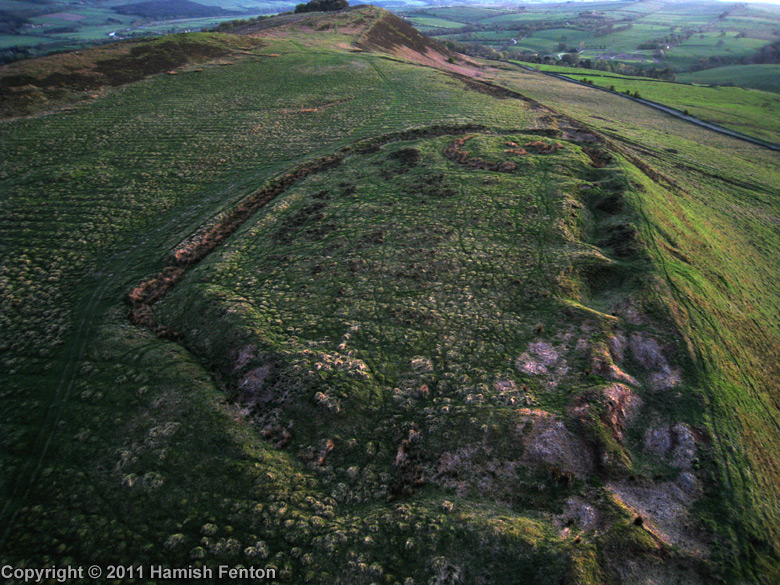
Barcombe Hill Settlement submitted by h_fenton on 22nd Jul 2011. Barcombe Hill Settlement viewed from the northeast with low evening light. The feature at the far end of the settlement is the Roman Signal Station
Kite Aerial Photograph
24 April 2011
(View photo, vote or add a comment)
Log Text: Barcombe Hill Iron Age Defended Settlement and Roman Signal Station: On a very hot bank holiday Saturday, we decided to try and go somewhere a little cooler, so set off towards Bardon Mill (OK, I was born to live in Scandanavia, not hotter climes). We'd previously tried to visit this site but used a route from nearer the Long Stone, on a day when dog races were taking place and there were lots and lots of people, plus when we approached the settlement, there was a huge bull and his ladies (we beat a hasty retreat).
Today we parked by the junction of Stanegate with the minor road running to Bardon Mill through Westend Village. A gate led us into the field and there was a mowed trackway leading up to the settlement (a note on the gate said the Open Access land was closed for the week before and a few days after our visit). We wandered over the settlement - the bank and ditch on the southern side is well preserved, but the northern edge has been quarried and there are some deep holes.
Making our way over to the Roman Signal station, I saw Andrew fall over in slow motion - his foot had gone down a hidden rabbit hole up to his knee. Once we'd spotted these holes, which were everywhere, we kept to the sheep tracks to avoid falling again.
After walking round the settlement, we made our way up to the Trig Point to get a view down.
Priest's Well (Bewcastle)
Trip No.69 Entry No.3 Date Added: 6th May 2018
Site Type: Holy Well or Sacred Spring
Country: England (Cumbria)
Visited: Yes on 23rd Apr 2018. My rating: Condition -1 Ambience 3 Access 4

Priest's Well (Bewcastle) submitted by Anne T on 6th May 2018. This photograph was taken from the south eastern corner of the churchyard, the current landforms seeming to indicate that a spring once issued from here, disappearing into the Kirk Beck below.
(View photo, vote or add a comment)
Log Text: Priest's Well, Bewcastle (site of): As the ground was far too boggy to go and see the three cairns to the west of Parkgate Bridge, I found this well marked on the OS map, so we decided to go and see it. Arriving at St. Cuthbert’s and the Bewcastle Cross, we orientated ourselves with the map to find the well is actually on private farmland. The farmer was busy driving around the field in his tractor, so we decided we could probably see the well from the eastern end of the churchyard.
We did see some indication of where the site of the well was, but there was no well housing or water flowing. I could find very little information on this well, apart from the mention in the Old Cumbria Gazetteer, which says it is a spring. As I finished photographing the site of where the well probably was, drizzle started to hurtle down.
Askerton Park
Trip No.69 Entry No.1 Date Added: 5th May 2018
Site Type: Ancient Village or Settlement
Country: England (Cumbria)
Visited: Yes on 23rd Apr 2018. My rating: Condition 2 Ambience 3 Access 4

Askerton Park submitted by Anne T on 5th May 2018. Right in the middle of the settlement and just a little to its eastern side, there is a wide stoney bank which looks as if this may have been part of the main dwelling described in the Pastscape record. All around here the moles had been very active, and many shards of pottery had come to the surface.
(View photo, vote or add a comment)
Log Text: Askerton Park Settlement: This is marked on the OS map, so we stopped at the northern end of Parkgate Bridge, where there is room to pull off the road and put on our wellies. We let ourselves in through the gate and tramped over the fields, entering the settlement from its north eastern side.
This settlement is fascinating, as its basically on a promontory between the Cam Back and Melefarm beck. Hollow ways run from the eastern part of the settlement to the Cam Beck, and there is another hollow way which picks up almost half way across the settlement, leading to Cam Beck. Following the latter trackway to the burn, there are the obvious remains of a cairn.
It was really interesting walking across the tops of the enclosure banks, which stood out a brighter green with shorter grass than the surrounding wheat-coloured taller stalks. There were lots of stones in the banks. The moles had had a field day, and I picked up a couple of the many pieces of pottery that had come to the surface of a mole hill (I wasn't certain they were pots until I got home and saw the inclusions and felt the lightness of the pot as opposed to some odd shaped stones).
Towerbrae Cairn
Trip No.69 Entry No.2 Date Added: 5th May 2018
Site Type: Cairn
Country: England (Cumbria)
Visited: Saw from a distance on 23rd Apr 2018. My rating: Condition 2 Ambience 3 Access 4
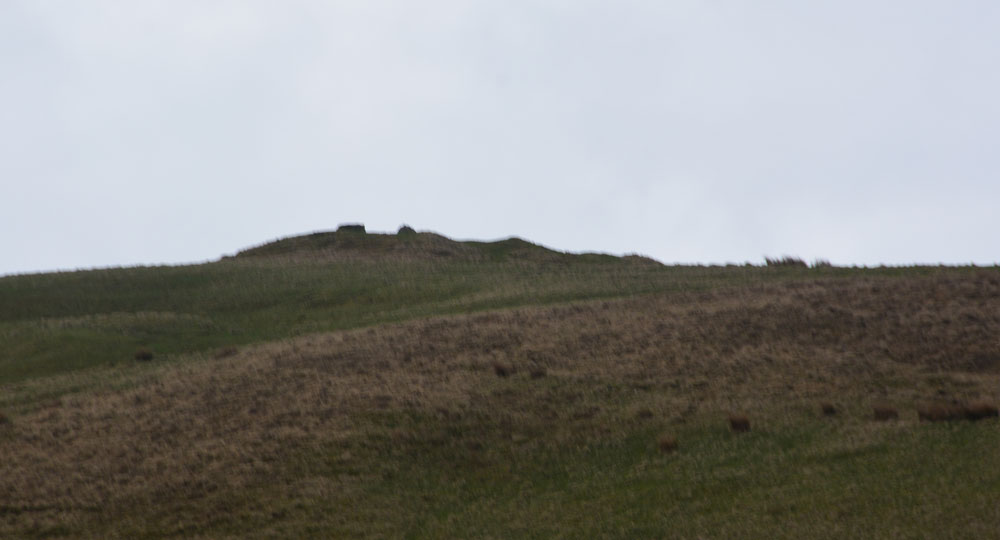
Towerbrae Cairn submitted by Anne T on 5th May 2018. This very blurry photograph was taken from the road just north of Luke's Cottage. We had planned to walk up to the cairn, but moments later a heavy downpour sent us up to the Bewcastle Cross instead.
(View photo, vote or add a comment)
Log Text: Towerbrae Cairn, Near Bewcastle: We stopped on the road to St. Cuthbert's, Bewcastle to find out how to walk to this cairn, which was basically up a quad bike track just south of Luke's Cottage. As there was nowhere near to park on a grass verge, we decided to go onto try and find Priest's Well at Bewcastle and stop on the way back.
The weather intervened, and a heavy downpour and heavy black clouds stopped us from doing this walk, but we will come back again.
The cairn is highly visible in the landscape. Apparently there is a modern marker on the cairn, and I'd like to complete our trip by returning soon.
Tullie House Museum
Date Added: 29th Apr 2018
Site Type: Museum
Country: England (Cumbria)
Visited: Yes on 20th Apr 2018. My rating: Condition 4 Ambience 4 Access 5
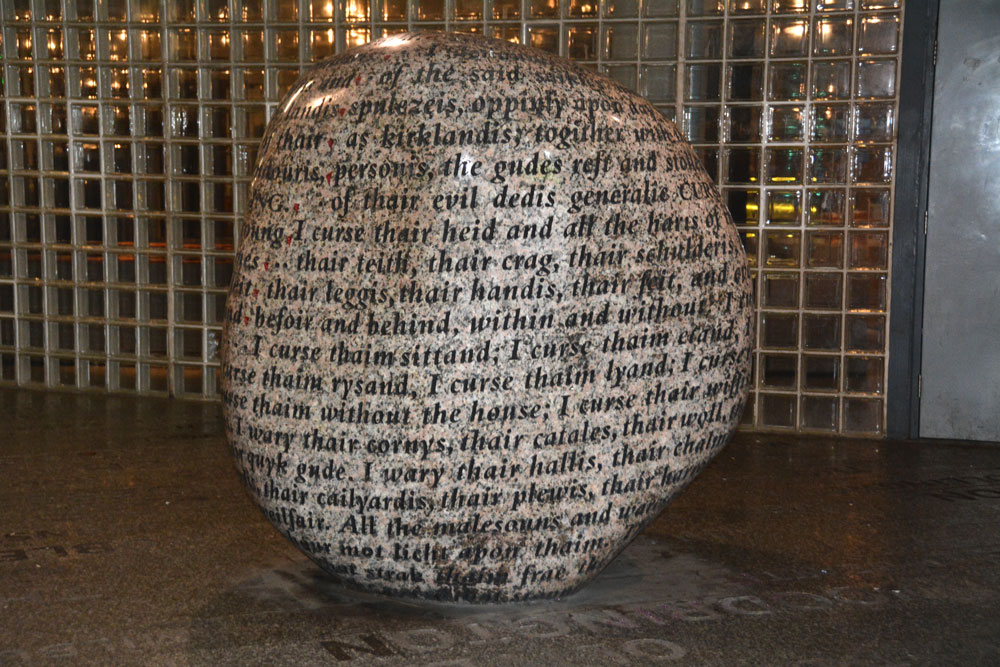
Tullie House Museum submitted by Anne T on 19th Sep 2017. Walking around the Cursing Stone - a bit difficult to photograph in what is largely a dimly lit pedestrian underpass with bright lights illuminating a few spots and shining off the stone.
(View photo, vote or add a comment)
Log Text: Tullie House Museum, Carlisle: We went to see the copy of the Bewcastle Cross and the Anglo Saxon cross fragments I'd seen photos of some years ago. The Bewcastle Cross copy no longer stands in the main entrance lobby, but is now in storage, and there are only a couple of rock art panels on display, along with Celtic gods (all displayed behind glass).
There was a very interesting video, and a display of associated artefacts, of the Langdale Axe factory.
A small museum, but interesting, even the Roman gallery in the basement, which has lots of interactive displays for children.
We bought a year pass for £10 each, which means we can return at any time for free until the end of April 2019. I've asked permission to go back to use their learning resource to find out more about the Celtic god sculptures.
Castlesteads (Lowther)
Trip No.68 Entry No.6 Date Added: 10th Apr 2018
Site Type: Misc. Earthwork
Country: England (Cumbria)
Visited: Yes on 5th Apr 2018. My rating: Condition 2 Ambience 4 Access 4

Castlesteads (Lowther) submitted by Anne T on 10th Apr 2018. Approaching the earthworks from its north western side. The bank rises rapidly from the River Lowther below. It's a very strategic spot on a curve of the river.
(View photo, vote or add a comment)
Log Text: Castlesteads Earthworks, Lowther Castle: This Castlesteads (as opposed to the Iron Age settlement we visited next) is just over 220 metres south of the gate into St. Michael’s Churchyard.
Being on a high spot above a bend in the River Lowther, it looks like a very strategic spot to build a defensive structure. In fact, Pastscape says it’s the remains of an old Pele Tower or other medieval building.
Hidden in the woods, but with a footpath leading to it, it is an intriguing ruin, with high banks on all four sides of a rectangle and remnants of the masonry on its western edge.
King Arthur's Round Table
Trip No.68 Entry No.8 Date Added: 7th Apr 2018
Site Type: Henge
Country: England (Cumbria)
Visited: Yes on 5th Apr 2018. My rating: Condition 3 Ambience 4 Access 5
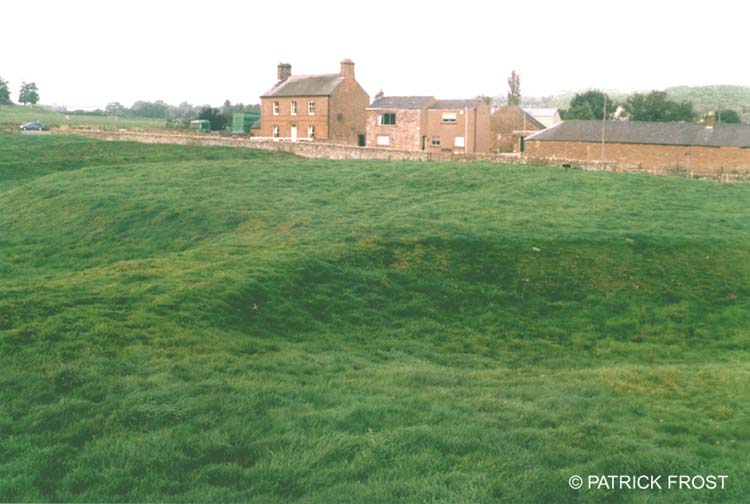
King Arthur's Round Table submitted by Patrick Frost on 14th Oct 2002. King Arthur's Round Table in Cumbria.
(View photo, vote or add a comment)
Log Text: King Arthur's Round Table Henge, Eamont Bridge: We tried to stop here on the way down to Langwathby, but the traffic was so dense and moving in so many different directions at the traffic lights, we decided to try when it was quieter. Thankfully, we managed to park in the layby opposite on the way back and let ourselves in through the kissing gate by the western side of the A66.
The scale of this monument is huge, and we walked all around its outer bank, trying to photograph the whole. Well worth stopping off and taking a look.
I didn't realise until I got home and was looking up information that there is a Little Round Table henge at NY 52387 28180.
Castlesteads (Yanwath Wood)
Trip No.68 Entry No.7 Date Added: 7th Apr 2018
Site Type: Ancient Village or Settlement
Country: England (Cumbria)
Visited: Yes on 5th Apr 2018. My rating: Condition 2 Ambience 3 Access 3

Castlesteads (Yanwath Wood) submitted by Anne T on 7th Apr 2018. Standing just inside the inner bank on the north western side of the enclosure looking across a ditch and two banks.
(View photo, vote or add a comment)
Log Text: Castlesteads (Yanwath Woods), Cumbria: This hillfort/enclosure is a pleasant stroll away from St. Michael’s Church and Lowther Castle, along footpaths and forest tracks, crossing the River Lowther either on the road or the footpath. After crossing the river, we followed the forest track north then to the west when the track split some 100 metres or so after the river crossing. The track following the river was full of dog walkers from the nearby holiday/caravan park, although heading up into the forest, it was peaceful and calm.
This was a very strange site, as there is higher ground to the north/north west of this enclosure. There were some huge boulders within the interior of the enclosure. Some made up what seemed to be wall lines, others just seemed scattered about.
The northern part of the enclosure seems to have been clipped by the construction of the forest track, and this has removed the outer banks and ditches on this side.
St Michael (Lowther)
Trip No.68 Entry No.4 Date Added: 7th Apr 2018
Site Type: Ancient Cross
Country: England (Cumbria)
Visited: Yes on 5th Apr 2018. My rating: Condition 3 Ambience 3 Access 5

St Michael (Lowther) submitted by Anne T on 7th Apr 2018. This grave cover, now broken into two parts, can be found against the western wall of the porch. It is recorded as AS Corpus Lowther 07a-b and is dated to the 10th century.
(View photo, vote or add a comment)
Log Text: Ancient Cross and hogback fragments, Lowther: We arrived here eager to see the hogback and grave covers detailed on the Corpus of Anglo Saxon Stone Sculpture Volume II, but on arriving at the church, the door appeared to be locked. There were a few broken panels in the south window of the porch, so I resorted to trying to take photos through the window, but there was no light. I called up the Corpus on my phone to see what might be in the churchyard rather than inside the church and came up with Lowther 10, which is built into the retaining wall of the churchyard where it drops down to the River Lowther, 9m from the south west corner of the church. Andrew walked all the way round, whilst I stayed in the churchyard marking the spot, but despite having the Corpus photograph, this stone appeared to be too worn to identify.
In disappointment, I went and rattled at the church door again, a little more boisterously than before and as I let the handle go, heard the latch click and the door came open. We made our way inside the church. There are supposed to be a number of fragments in the porch, but only found 2 that are recorded on the Corpus.
There are three more fragments tucked away against the west wall of the north transept, and I had to go and get my large flash gun to take photographs. Only two of these are recorded on the Corpus.
This is a really strange church. Despite its size, it feels more like a mausoleum rather than a church, and I was glad to get out into the sunshine to find the cross in the churchyard.
Roman Milestone (Temple Sowerby)
Trip No.68 Entry No.3 Date Added: 6th Apr 2018
Site Type: Marker Stone
Country: England (Cumbria)
Visited: Yes on 5th Apr 2018. My rating: Condition 3 Ambience 3 Access 5
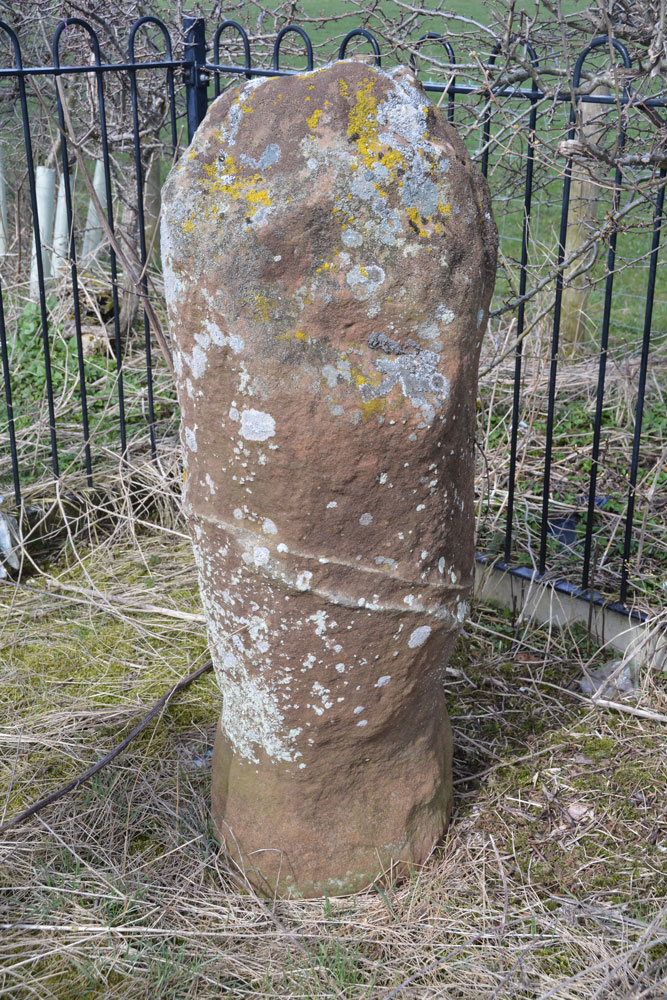
Roman Milestone (Temple Sowerby) submitted by Anne T on 6th Apr 2018. Close up of the southern face of the milestone. If there was an inscription, it has long been scoured away by the winds and rains. Today the A66 Temple Sowerby by-pass rushes by just to the west of this milestone. To think this has sat by a routeway for around 2,000 years.
(View photo, vote or add a comment)
Log Text: Roman Milestone, in its original position, Temple Sowerby: This was a very curious site - now a newly created 'dead end' and technically a private road. The milestone is hidden behind a mound of dirt and stones at the side of the road, protected by a metal railing. Traffic on the he modern A66 Temple Sowerby by-pass whizzes by at high speed. Shame the railing and hedge behind attracts so much rubbish - really spoiled the ambience.
To think this has been on an ancient routeway for such a long time. The weather has long scoured away any inscription. I have been trying to find out how they know it's in its original location, but haven't found out anything (yet).
St. Cuthbert's Church (Edenhall)
Trip No.68 Entry No.2 Date Added: 6th Apr 2018
Site Type: Ancient Cross
Country: England (Cumbria)
Visited: Yes on 5th Apr 2018. My rating: Condition 3 Ambience 4 Access 5

St. Cuthbert's Church (Edenhall) submitted by Anne T on 6th Apr 2018. Close up of the carved Anglo Saxon cross in the exterior north of the wall. Just to its east, and higher up the wall, is a blocked up Anglo Saxon window/window head.
(View photo, vote or add a comment)
Log Text: Anglo Saxon Cross at St. Cuthbert's Church, Edenhall: There is a small car park to the north of the church, and a tall/wide gate with a stile next to it to access the churchyard. This is a pretty, red sandstone building which looks as if it has been extended many times in antiquity.
There was no mention of anything on the Corpus of Anglo Saxon Stone Sculpture, although the church guide book mentions “the chancel appears to be pre-Norman or early Norman origin, and a small blocked up window high up in this wall is of Anglo Saxon type. Moreover, on the same wall, lower down, there is a carved Anglo Saxon cross. Thus the north wall may be the remains of an earlier church.”
The guide also mentions a Mass Dial on the south wall, to the east of the porch. We both spent about 20 mins looking up and down the length of the wall, both east and west of the porch, in strong sunlight which would have brought the markings out, but failed to find this. We did spot what looked like two fragments of carved cross shaft in the south wall of the tower, west of the porch. There was no mention of these in the guide or Pastscape or HE notes.
